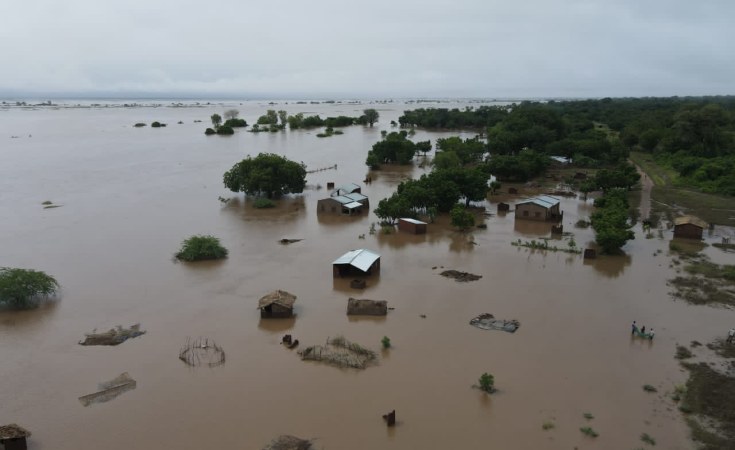Sensitive campaigners are finding that belief in Napolo, a legendary multi-headed monster, is no barrier to environmental understanding and action.
In March earlier this year, Mary Phiri, 40, was at her home in Chilobwe, southern Malawi, when she heard a peculiar rumbling sound in the distance. It got louder until, moments later, an avalanche of mud and rocks hurtled down the nearby Soche Mountain, sweeping away everything in its path. The surrounding area was soon hit by flash floods that washed away homes, bridges, and infrastructure. A nationwide blackout followed as over 200,000 hectares of cropland were ruined just days before they were about to be harvested.
For meteorologists, these impacts came as a shock but not a surprise. Weeks earlier in early-February, they had watched as a disturbance in the ocean near Australia developed into a full-blown cyclone as it crossed the Indian Ocean towards Africa. Due to climate change, storm systems have become more intense and prolonged. This tempest exemplified this pattern, affecting millions of people across Madagascar and Mozambique, and leaving thousands dead or missing, mostly in Malawi. By the time it finally dissipated in mid-March, it had become the longest-lasting and highest-energy-producing cyclone ever recorded.
The world knew the cause of the catastrophe as Cyclone Freddy, a name synonymous with the unpredictability and injustice of the man-made climate crisis.
In southern Malawi, Phiri and others similarly scrambled to make sense of the devastating events. However, to explain the inexplicable, they looked not to new science but to old legends. For them, only one name came to mind: Napolo.
According to local myth, Napolo is a giant many-headed snake that lives in a deep sacred pool under the mountains in southern Malawi. When it emerges from its hiding place and moves, devastation ensues. Its movement causes huge floods and landslides as the sound of drumming echoes across the region.
"This was not a natural occurrence," Phiri told African Arguments earlier this year while standing on remains of what had been her two-bedroom home. "Nobody can dispute that it was Napolo."
The story of Napolo can be traced back to a flash flood in 1946. Ever since, several disasters and cyclones have been blamed on the snake's migratory patterns. In many communities, deeply embedded tradition beliefs have remained strong, even amid growing awareness of climate change and the damaging effects of human behaviour.
"The scientific explanation of flash floods is enlightening and intellectually liberating but, in terms of charisma, it cannot beat the image of a fiery and smoky serpent roaring down the mountain slopes to the accompaniment of the loudest drums, flutes, and whistles," says Ken Lipenga, a writer and politician.
For some, the predominance of traditional beliefs might seem like a barrier to sensitising people about climate change and the growing risks from natural hazards. However, several Malawian artists and environmentalists have recognised the opportunity of using the well-known story of Napolo to spread important messages.
Sosten Chiotha is the Regional Director of the Leadership for Environment and Development (LEAD) in Southern and Eastern Africa. His organisation has been engaging with local perspectives on climate change since 2008. He says that certain traditional beliefs are directly harmful, citing the example of elderly women being blamed for causing dry spells. "If the explanations are detrimental, we should dismiss them," he says. "We need to completely dispel the ones that are harmful with alternative scientific explanations."
However, his work has also found that some myths have great potential to help widen understanding. By using familiar legends, campaigners can meet communities where they are and ensure their messages resonate with existing beliefs and practices.
"The legend of Napolo is harmless since you can tell the people how they can prepare for it by planting trees and staying away from risk areas," says Chiotha.
A number of Malawian artists and musicians have been doing just this as they try to share messages about climate change in ways that work with - rather than against - traditional ways of relating to nature.
Elias Gaveta of Conservation Arts Malawi, for instance, runs a Folklore Project together with local chiefs to educate younger generations. The elders share knowledge about the past and how things have changed from their traditional viewpoints, which Gaveta and his colleagues then complement with scientific explanations.
"What we're doing is just adding in science and climate change messages," he says. "Cyclones are natural and Napolo was a cyclone. The only difference now is that the impact and frequency of those cyclones has been enhanced with human activities and that we do not have adequate green infrastructure to protect our home and farms."
By engaging with communities in this way, Gaveta has also learned more about local legends in ways that have helped him shape messages about the environment and sustainable practices.
"There is an interesting side to Napolo," he says. "Some people told us the snake would come out when it's angry or provoked, so we advise them not to cut down trees or encroach the mountains to avoid angering those spirits."
Evans Chimwala, 30, takes a similar approach using music. Also known as Evans Muzik, the local rapper recently released a song called "Napolo" narrating the story of a victim of Cyclone Freddy. Chimwala says he made the song to console people affected by cyclone, and that he used Napolo to help it resonate with listeners. "Water burst from the mountain. Rocks were mixed with mud. Houses fell like they were built of cotton," he sings on the track.
Chimwala similarly suggests that the legend can be a help - not a hindrance - to spreading understanding of climate change and man-made environmental damage. In fact, he suggests that this may have long been the underlying message of the myth.
"My take is that our ancestors understood that Napolo occurred whenever people had wronged nature including cutting down trees. We should believe the legend," he advises.
Charles Pensulo is a Malawian freelance journalist.


